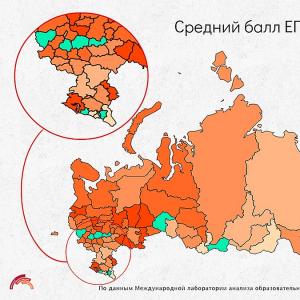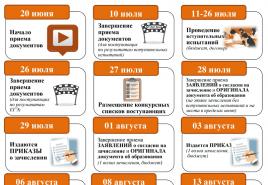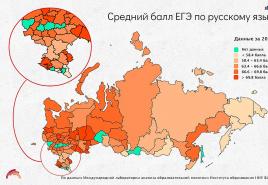Laboratory 1 study of body movement in a circle. Laboratory work
Elasticity and gravity
Objective
Determination of the centripetal acceleration of the ball when it uniform movement circumferentially
The theoretical part of the work
The experiments are carried out with a conical pendulum: a small ball suspended by a thread moves in a circle. In this case, the thread describes a cone (Fig. 1). Two forces act on the ball: the force of gravity and the force of elasticity of the thread. They create centripetal acceleration directed radially towards the center of the circle. The acceleration module can be determined kinematically. It is equal to:

 To determine the acceleration (a), you need to measure the radius of the circle (R) and the period of revolution of the ball around the circle (T).
To determine the acceleration (a), you need to measure the radius of the circle (R) and the period of revolution of the ball around the circle (T).
Centripetal acceleration can be defined in the same way using the laws of dynamics.
According to Newton's second law,  Let's write given equation in projections on the selected axes (Fig. 2):
Let's write given equation in projections on the selected axes (Fig. 2):
Oh:  ;
;
Oy:  ;
;
From the equation in projection onto the Ox axis, we express the resultant: 
From the equation in projection onto the Oy axis, we express the elastic force: 
Then the resultant can be expressed: 
and hence the acceleration:  , where g \u003d 9.8 m / s 2
, where g \u003d 9.8 m / s 2
Therefore, to determine the acceleration, it is necessary to measure the radius of the circle and the length of the filament.
Equipment
A tripod with a clutch and a foot, a measuring tape, a ball on a thread, a sheet of paper with a drawn circle, a watch with a second hand
Progress
1. Hang the pendulum on the tripod leg.
2. Measure the radius of the circle with an accuracy of 1mm. (R)
3. Position the tripod with the pendulum so that the extension of the cord passes through the center of the circle.
4. Take the thread at the suspension point with your fingers, rotate the pendulum so that the ball describes a circle equal to the one drawn on the paper.
6. Determine the height of the conical pendulum (h). To do this, measure the vertical distance from the suspension point to the center of the ball.
7. Find the acceleration module by the formulas:


8. Calculate the error.
Table Results of measurements and calculations
Calculations
1. Circulation period:  ; T \u003d
; T \u003d
2. Centripetal acceleration:
 ; a 1 \u003d
; a 1 \u003d
 ; a 2 \u003d
; a 2 \u003d
Average centripetal acceleration:
 ; and cf \u003d
; and cf \u003d
3. Absolute error: 
∆а 1 \u003d
∆а 2 \u003d
4. Average value of the absolute error:  ; Δa av \u003d
; Δa av \u003d
5. Relative error:  ;
;
Output
Record Answers to questions with full sentences
1. Formulate the definition of centripetal acceleration. Write it down and the formula for calculating the acceleration when moving in a circle.
2. Formulate Newton's second law. Write down its formula and wording.
3. Write down the definition and formula to calculate
gravity.
4. Write down the definition and formula for calculating the elastic force.
LABORATORY WORK 5
Body movement at an angle to the horizon
goal
Learn to determine the altitude and range of flight when the body moves with an initial speed directed at an angle to the horizon.
Equipment
Model "Motion of a body thrown at an angle to the horizon" in spreadsheets
Theoretical part
The movement of bodies at an angle to the horizon is a complex movement.
Motion at an angle to the horizon can be divided into two components: uniform motion along the horizontal (along the x-axis) and simultaneously uniformly accelerated, with acceleration of gravity, along the vertical (along the y-axis). This is how a skier moves when jumping from a springboard, a stream of water from a cannon, artillery shells, throwing shells
Equations of motion s w: space \u003d "720" /\u003e"> ![]() and
and ![]()
 we write in projections on the x and y axes:
we write in projections on the x and y axes:
On the X axis: ![]() S \u003d
S \u003d ![]()
![]()
To determine the flight altitude, it is necessary to remember that at the top of the ascent, the body's speed is 0. Then the ascent time will be determined: ![]()
When falling, the same time passes. Therefore, the travel time is defined as
![]()
Then the lifting height is determined by the formula:
And the flight range:
The greatest flight range is observed when moving at an angle of 45 0 to the horizon.
Progress
1. Write down the theoretical part of the work in your workbook and sketch the graph.
2. Open the file "Motion at an angle to the horizon.xls".
3. In cell B2, enter the value of the initial speed, 15 m / s, and in cell B4, the angle of 15 degrees (only numbers are entered into cells, without units of measurement).
4. View the result on the graph. Change the speed value to 25 m / s. Compare charts... What changed?
5. Change the speed values \u200b\u200bto 25 m / s and the angle –35 degrees; 18 m / s, 55 degrees. Consider the charts.
6. Perform formulas for velocities and angles (by options):
8. Check your results, look at the graphs. Draw charts to scale on a separate A4 sheet
Table Values \u200b\u200bof sines and cosines of some angles
| 30 0 | 45 0 | 60 0 | |
| Sine (Sin) | 0,5 | 0,71 | 0,87 |
| Cosine (Cos) | 0,87 | 0,71 | 0,5 |
Output
Write down the answers to the questions full sentences
1. On what values \u200b\u200bdoes the flight range of a body thrown at an angle to the horizon depend?
2. Give examples of the movement of bodies at an angle to the horizon.
3. At what angle to the horizon is the longest flight range of the body at an angle to the horizon observed?
LABORATORY WORK 6
3. Calculate and enter into the table the average value of the time interval<t\u003e, for which the ball commits N \u003d 10 turns.
4. Calculate and enter into the table the average value of the rotation period<T\u003e ball.

5. Using the formula (4), determine and enter into the table the average value of the acceleration module.

6. Using formulas (1) and (2), determine and enter into the table the average value of the modules of the angular and linear velocity.

| Experience | N | t | T | a | ω | v |
| 1 | 10 | 12.13 | — | — | — | — |
| 2 | 10 | 12.2 | — | — | — | — |
| 3 | 10 | 11.8 | — | — | — | — |
| 4 | 10 | 11.41 | — | — | — | — |
| 5 | 10 | 11.72 | — | — | — | — |
| Wed | 10 | 11.85 | 1.18 | 4.25 | 0.63 | 0.09 |
7. Calculate the maximum value of the absolute random error in measuring the time span t.

8. Determine the absolute systematic error of the time span t .

9. Calculate the absolute error of direct measurement of the time span t .

10. Calculate the relative error of direct measurement of the time span.

11. Record the result of the direct measurement of the time span in interval form.

Answer security questions
1. How will the linear speed of the ball change with its uniform rotational motion relative to the center of the circle?
Linear velocity is characterized by direction and magnitude (modulus). The modulus is a constant value, and the direction can change with such a movement.
2. How to prove the ratio v = ωR?
Since v \u003d 1 / T, the connection cyclic frequency with a period and frequent 2π \u003d VT, whence V \u003d 2πR. The relationship between the linear velocity and the angular 2πR \u003d VT, hence V \u003d 2πr / T. (R is the radius of the inscribed, r is the radius of the inscribed)
3. How the rotation period depends T ball from the module of its linear velocity?
The higher the speed indicator, the smaller the period indicator.
Conclusions: learned to determine the period of rotation, modules, centripetal acceleration, angular and linear velocities with uniform rotation of the body and calculate the absolute and relative errors of direct measurements of the time interval of body movement.
Super mission
Determine the acceleration of a material point during its uniform rotation, if for Δ t \u003d 1 s, she passed 1/6 of the circumference, having a linear velocity modulus v \u003d 10 m / s.
Circumference:
S \u003d 10 ⋅ 1 \u003d 10 m
l \u003d 10⋅ 6 \u003d 60 m
Circle radius:
r \u003d l / 2π
r \u003d 6/2 ⋅ 3 \u003d 10 m
Acceleration:
a \u003d v 2 / r
a \u003d 100 2/10 \u003d 10 m / s2.
№ 1. Study of body movement in a circle
Objective
Determine the centripetal acceleration of the ball when it moves uniformly around the circumference.

Theoretical part
Experiments are carried out with a conical pendulum. A small ball moves in a circle with a radius R. In this case, the thread AB, to which the ball is attached, describes the surface of a straight circular cone. It follows from the kinematic relations that аn \u003d ω 2 R \u003d 4π 2 R / T 2.
Two forces act on the ball: the force of gravity m and the tension force of the thread (Fig. L.2, a). According to Newton's second law, m \u003d m +. Having decomposed the force into components 1 and 2, directed radially to the center of the circle and vertically upward, we write Newton's second law as follows: m \u003d m + 1 + 2. Then you can write: mа n \u003d F 1. Hence a n \u003d F 1 / m.
The modulus of the component F 1 can be determined using the similarity of triangles OAB and F 1 FB: F 1 / R \u003d mg / h (| m | \u003d | 2 |). Hence F 1 \u003d mgR / h and a n \u003d gR / h.
Let us compare all three expressions for a n:
and n \u003d 4 π 2 R / T 2, and n \u003d gR / h, and n \u003d F 1 / m
and make sure that the numerical values \u200b\u200bof the centripetal acceleration obtained in three ways are approximately the same.
Equipment
A tripod with a clutch and a foot, a measuring tape, a compass, a laboratory dynamometer, a balance with weights, a ball on a thread, a piece of cork with a hole, a sheet of paper, a ruler.
Work order
1. Determine the mass of the ball on the balance to the nearest 1 g.
2. Pass the thread through the hole in the plug and clamp the plug in the tripod leg (Fig. L.2, b).
3. Draw a circle on a piece of paper with a radius of about 20 cm. Measure the radius to the nearest 1 cm.
4. Position the stand with the pendulum so that the extension of the thread passes through the center of the circle.
5. Taking the thread with your fingers at the suspension point, rotate the pendulum so that the ball describes the same circle as the one drawn on the paper.
6. Count the time during which the pendulum makes a given number (for example, in the range from 30 to 60) revolutions.
7. Determine the height of the conical pendulum. To do this, measure the vertical distance from the center of the ball to the suspension point (consider h ≈ l).
![]()
9. Pull the ball with a horizontally located dynamometer to a distance equal to the radius of the circle, and measure the modulus of component 1.
Then calculate the acceleration using the formula

Comparing the obtained three values \u200b\u200bof the modulus of centripetal acceleration, we make sure that they are approximately the same.
.
I Preparatory stage
 The picture shows a schematic of a swing known as giant steps. Find the centripetal force, radius, acceleration and speed of rotation of the person on the swing around the pole. The length of the rope is 5 m, the weight of a person is 70 kg. The pole and the rope form an angle of 300 when they are turned. Determine the period if the swing frequency is 15 min-1.
The picture shows a schematic of a swing known as giant steps. Find the centripetal force, radius, acceleration and speed of rotation of the person on the swing around the pole. The length of the rope is 5 m, the weight of a person is 70 kg. The pole and the rope form an angle of 300 when they are turned. Determine the period if the swing frequency is 15 min-1.
Hint: A body in a circular motion is affected by the force of gravity and the elastic force of the rope. Their resultant imparts centripetal acceleration to the body.
Enter the calculation results into the table:
Treatment time, s
Speed
Circulation period, s
Turning radius, m
Body weight, kg
centripetal force, N
circulation speed, m / s
centripetal acceleration, m / s2
II... The main stage
Objective:
Devices and materials:
1.  Before the experiment, a weight, previously weighed on a balance, is suspended on a thread from the tripod leg.
Before the experiment, a weight, previously weighed on a balance, is suspended on a thread from the tripod leg.
2. Under the hanging weight, place a sheet of paper with a circle drawn on it with a radius of 15-20 cm. Place the center of the circle on a plumb line passing through the suspension point of the pendulum.
3. At the suspension point, the thread is taken with two fingers and the pendulum is carefully set in rotational motion so that the radius of rotation of the pendulum coincides with the radius of the drawn circle.
4. Bring the pendulum to rotation and counting the number of revolutions measure the time during which these revolutions occurred.
5. Record the results of measurements and calculations in the table.
6. The resultant force of gravity and elastic force found during the experiment is calculated from the parameters of the circular motion of the load.

On the other hand, the centripetal force can be determined from the proportion
Here the mass and radius are already known from previous measurements, and in order to determine the centrifugal force in the second way, it is necessary to measure the height of the suspension point above the rotating ball. For this, the ball is pulled back to a distance equal to the radius of rotation and the vertical distance from the ball to the suspension point is measured.
7. Compare the results obtained by the two different ways and make a conclusion.
III Control stage
In the absence of scales at home, the purpose of the work and the equipment can be changed.
Objective: measurement of linear velocity and centripetal acceleration with uniform circular motion
Devices and materials:

1. Take a double-stranded needle, 20-30 cm long. Insert the tip of the needle into an eraser, small onion, or a plasticine ball. You will receive a pendulum.
2. Lift your pendulum by the free end of the thread above the sheet of paper lying on the table, and bring it into uniform rotation around the circle shown on the sheet of paper. Measure the radius of the circle along which the pendulum moves.
3. Achieve stable rotation of the ball along a given trajectory and, by the hour with a second hand, fix the time for 30 revolutions of the pendulum. Calculate the moduli of linear velocity and centripetal acceleration using known formulas.
4. Create a table to record the results and fill it in.
References:
1. Frontal laboratory classes in physics in high school. A guide for teachers, edited by. Ed. 2nd. - M., "Education", 1974
2. Shilov work at school and at home: mechanics.-M .: "Education", 2007
Study of body movement in a circle under the influence of elastic and gravity forces.
Purpose of the work: determination of the centripetal acceleration of the ball with its uniform movement around the circumference.
Equipment: a tripod with a clutch and a foot, a measuring tape, a compass, a laboratory dynamometer, a balance with weights, a ball on a thread, a piece of cork with a hole, a sheet of paper, a ruler.
1. Let us bring the load into rotation along the drawn circle of radius R \u003d 20 cm. We measure the radius with an accuracy of 1 cm. We measure the time t, during which the body will make N \u003d 30 revolutions.
2. Determine the height of the conical pendulum h vertically from the center of the ball to the suspension point. h \u003d 60.0 + - 1 cm.
3.Pull the ball with a horizontally located dynamometer to a distance equal to the radius of the circle and measure the modulus of the component F1 F1 \u003d 0.12 N, the mass of the ball m \u003d 30 g + - 1 g.
4. The measurement results are entered into the table.
5. Let's calculate an by the formulas given in the table.
6.The result of the calculation is entered into the table.
Conclusion: comparing the obtained three values \u200b\u200bof the centripetal acceleration modulus, we make sure that they are approximately the same. This confirms the correctness of our measurements.







